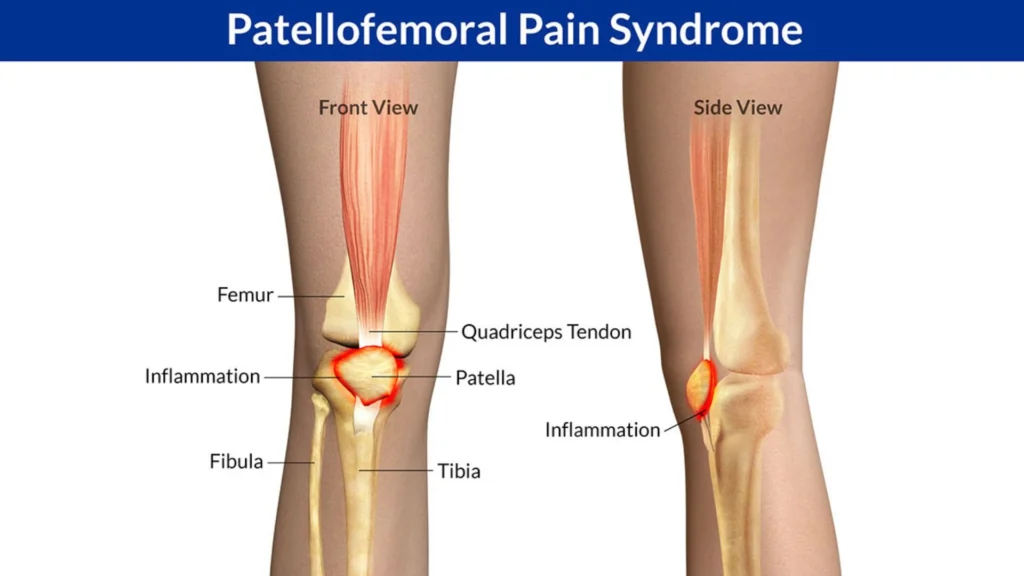Knee pain is a common concern for many people, especially those engaged in active lifestyles or dealing with sports injuries in Winnipeg. While there can be many reasons behind anterior knee pain, two of the most frequent causes are Patellar Tendinitis and Patellofemoral pain syndrome (PFPS), which are often confused due to their similar symptoms.
Though both affect the knee area, they have distinct symptoms and treatment approaches. Understanding their key differences is crucial for maintaining long-term knee health and promoting effective recovery. This blog provides a detailed insight into each condition, its common causes, symptoms to watch out for, and how physiotherapy for knee pain can help manage these conditions.
Patellofemoral Pain Syndrome vs Patellar Tendinitis: Key Differences
Patellar Tendinitis (Jumper’s Knee) commonly affects the patellar tendon, which joins the patella (kneecap) to the tibia (shinbone). This condition is usually caused by repeated stress on the joint. Whereas Patellofemoral pain syndrome (Runner’s Knee) is characterized by pain around the kneecap. This is typically caused by improper tracking of the patella in the femoral groove. While both conditions affect the knee area, they are not the same. Here is a detailed comparison between Patellar Tendinitis vs Runner’s Knee
Pain Location and Pattern
Patellar Tendinitis

People suffering from this condition are more likely to experience sharp and well-localized pain, generally just beneath the kneecap where the patellar tendon inserts into the tibia. The pain intensifies with activities like jumping, sprinting, or stair climbing. The discomfort is noticeable immediately after activity, especially in the early stages of the condition. If you are considering physio for Patellar Tendinitis, consider expert physiotherapy services in Winnipeg.
Patellofemoral Pain Syndrome

Individuals with this condition may experience a diffuse, aching sensation in the area around the kneecap. Unlike its counterpart, the pain is not easy to recognize. The discomfort is likely to worsen with activities that strain the knee in a bent position, including climbing stairs, squatting, or sitting for extended periods. People often describe the pain as a dull, nagging sensation rather than a sharp pain.
Onset and Trigger
Patellar Tendinitis
This knee condition develops gradually but is directly linked to repetitive strain or a sudden increase in physical activity. Since basketball is a widely played sport in Winnipeg, Canada, athletes are more likely to be affected by Patellar Tendinitis. Minor negligence and tight muscles in the legs can exacerbate this condition, so it is advised to adhere to the Patellar Tendinitis exercises recommended by a physiotherapist. Learn more about preventing sports injuries with our prevention guide.
Patellofemoral Syndrome
PFPS triggers are often caused by ongoing stress due to poor movement mechanics, not just from overuse. It occurs due to muscle imbalances, such as weak glutes, poor foot posture, or abnormal movement patterns. Activities that require bending the knee tend to make the pain worse.
Functional Limitations
Patellar Tendinitis
People with this type of anterior knee pain are unable to perform high-impact activities, including sprinting, lunging, or jumping. This is especially true during actions that require quick starts or stops, as the patellar tendon becomes overstressed. People with an active lifestyle or athletes, particularly, may push through the pain initially, but as the condition worsens, it can affect their performance and health. If you are an athlete, do not overlook the pain and consider physio for Patellar Tendinitis for rapid recovery.
Patellofemoral Pain Syndrome
Unlike Jumper’s Knee, individuals with PFPS often struggle with even low-impact activities. Sitting for long periods, kneeling, or standing up from a chair can become painful. Even walking downhill might cause discomfort due to improper patella movement. With the right Patellofemoral pain syndrome exercises, physiotherapists in Winnipeg can help improve knee mechanics, thereby alleviating pain and enhancing joint stability.
How Physiotherapy for Knee Pain Helps?
Using a combination of manual therapy, muscle-strengthening exercises, and targeted techniques, physiotherapists can effectively address the underlying issues associated with Jumper’s Knee and Runner’s Knee.
Pain Relief & Reduced Inflammation
Physiotherapy targets the root source of discomfort rather than masking the knee pain with painkillers. With a range of non-invasive techniques, physical therapy helps reduce swelling and calm inflamed tissues, providing patients with immediate symptom relief. Consistent physiotherapy sessions in Winnipeg aid in restoring normal joint mechanics and reducing dependence on medications.
Improved Range of Motion & Joint Flexibility
By incorporating stretching and joint mobilization techniques, physiotherapy experts help restore full, pain-free motion in stiff or swollen joints. As flexibility increases, individuals with Patellofemoral syndrome get back to performing daily activities without any discomfort. This approach helps prevent compensatory movements that could cause potential injuries in other joints.
Strengthened Muscles & Enhanced Joint Stability
A targeted Patellofemoral pain syndrome exercise program focused on the glutes, hamstrings, and hip stabilizers strengthened muscular support around the knee. Physiotherapy in Winnipeg helps improve muscle function that not only tolerates intense load but also offloads the joint, reduces pain, and prevents further damage. If you are suffering from knee pain, physio for Patellar Tendinitis can help you regain better control during movement and lower the risk of future injury.
Jumper’s Knee vs. Runner’s Knee Symptoms: When to Seek Professional Help
While Patellar Tendinitis (Jumper’s Knee) and Patellofemoral syndrome (Runner’s Knee) are both common causes of anterior knee pain, the severity and characteristics of their symptoms may differ. It is important to recognize when the symptoms may indicate a more serious issue. Here are some warning signs to watch out for:
Runner’s Knee
- Mild, aching pain in the kneecap area.
- A grinding sensation when bending the knee.
- Sharp pain during squatting, kneeling, or climbing stairs.
- Tenderness around the edges of the kneecap.
Jumper’s Knee
- Sharp, localized pain just below the kneecap.
- Swelling or thickening in the patellar tendon area.
- Pain that increases when straightening the leg under load.
- Sharp pain when placing weight on the affected leg.
If you’re experiencing symptoms, consult expert physiotherapists in Winnipeg for knee pain. Early diagnosis and professional physio for Patellar Tendinitis can prevent further stress on the knee joint. For a detailed overview of physiotherapy treatment techniques for knee relief, refer to this link: https://bridgwaterphysiotherapy.ca/treatment-techniques-of-physiotherapy-for-knee-pain-relief/.
Conclusion
Understanding the detailed comparison of Jumper’s Knee vs Runner’s Knee is crucial for managing knee pain effectively. Affecting the anterior knee area, these conditions can severely impact your daily life & athletic performance. However, with the right physiotherapy treatment in Winnipeg, recovery is possible. Unlike painkillers and other treatments, physical therapy addresses the root cause of pain through specialized Patellar Tendinitis exercises and other therapeutic approaches. Whether dealing with Patellar Tendinitis or Runner’s Knee, seeking timely professional care is crucial to regaining a pain-free and active lifestyle. At Bridgwater Physiotherapy, our team of expert physiotherapists in Winnipeg is ready to help you regain knee strength, mobility, and comfort. Book an appointment for physiotherapy for knee pain today.


